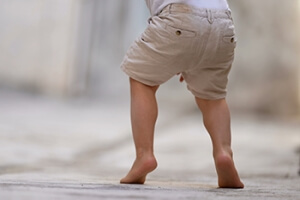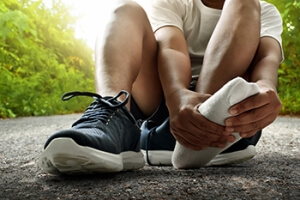Connect With Us
Featured Articles
Super User
Stay Safe on Your Feet This Fourth of July: Essential Foot Safety Tips
 As we gear up to celebrate Independence Day with fireworks, barbecues, and outdoor fun, it's crucial to remember the importance of foot safety. Whether you're planning to join a parade, attend a fireworks display, or simply enjoy a backyard gathering, taking care of your feet can ensure you have a blast without any unnecessary mishaps. Here are some essential tips to keep your feet safe this Fourth of July:
As we gear up to celebrate Independence Day with fireworks, barbecues, and outdoor fun, it's crucial to remember the importance of foot safety. Whether you're planning to join a parade, attend a fireworks display, or simply enjoy a backyard gathering, taking care of your feet can ensure you have a blast without any unnecessary mishaps. Here are some essential tips to keep your feet safe this Fourth of July:
1. Choose the Right Footwear: Wearing appropriate footwear is key to protecting your feet during holiday festivities. Opt for comfortable, sturdy shoes that provide adequate support and cushioning. Avoid open-toed sandals or flip-flops, especially if you'll be walking on uneven surfaces or near fireworks.
2. Mind the Heat: July can bring scorching temperatures, so be mindful of hot pavement, sand, or surfaces where you'll be walking. Prolonged exposure to hot surfaces can lead to burns or discomfort. If possible, walk in shaded areas or wear lightweight socks to protect your feet from direct contact with hot surfaces.
3. Be Aware of Fireworks Safety: If you're attending a fireworks display, keep a safe distance from where fireworks are being launched. Debris or sparks can inadvertently land on your feet, causing burns or injuries. Remain vigilant and follow all safety guidelines provided by event organizers.
4. Stay Hydrated: Proper hydration is not only essential for overall health but also for foot health. Dehydration can lead to muscle cramps, including in the feet. Ensure you drink enough water throughout the day, especially if you'll be spending time outdoors in warm weather.
5. Watch Your Step: With large crowds and festive activities, it's easy to overlook potential hazards on the ground. Watch out for discarded fireworks, sharp objects, or uneven terrain that could cause trips or falls. Stay attentive and encourage children to do the same.
6. Protect Against Sun Exposure: If you're going to be in the sun for an extended period, don't forget to apply sunscreen to your feet. The skin on your feet is just as susceptible to sunburn as any other part of your body. Choose a sunscreen with at least SPF 30 and reapply it regularly, especially after swimming or sweating.
7. Take Care of Existing Foot Conditions: If you have existing foot problems such as blisters, bunions, or plantar fasciitis, take extra precautions to avoid exacerbating these conditions. Consider using orthotic inserts or supportive footwear to alleviate discomfort and prevent further injury.
By following these foot safety tips, you can ensure that your Fourth of July celebrations are enjoyable and injury-free. Remember, taking care of your feet is an essential part of overall well-being, allowing you to fully participate in the festivities without any setbacks. Have a happy and safe Fourth of July!
Listen to Your Feet: What Foot Pain Says About Your Health
Our feet are remarkable structures, comprising intricate networks of bones, muscles, tendons, and ligaments that bear the weight of our entire body. When foot pain strikes, it's often a signal that something may be amiss within our bodies. In this blog post, we'll explore what foot pain could potentially reveal about your overall health and why paying attention to these signals is crucial for your well-being.
Localized Pain:
Heel Pain: Pain in the heel may indicate conditions such as plantar fasciitis, Achilles tendonitis, or heel spurs. It can also be a sign of improper footwear or excessive strain on the feet.
Ball of the Foot: Pain in the ball of the foot might suggest conditions like Morton's neuroma, metatarsalgia, or issues with the metatarsal bones.
Arch Pain:
Flat Feet or Fallen Arches: Persistent arch pain may be a sign of flat feet, which can contribute to various foot problems. Fallen arches can lead to overpronation, causing strain on the feet and ankles.
Toe Pain:
Bunions or Hammertoes: Bunions, often characterized by a bony bump at the base of the big toe, and hammertoes, where toes become bent or curled, can cause discomfort and affect your gait.
Gout: Intense pain in the big toe could be indicative of gout, a type of arthritis caused by the buildup of uric acid crystals in the joint.
Nerve Pain:
Peripheral Neuropathy: Numbness, tingling, or burning sensations in the feet may signal nerve damage, often associated with conditions like diabetes or other systemic disorders.
Swelling:
Edema: Swelling in the feet can be a symptom of underlying health issues such as heart, kidney, or liver problems. It may also result from poor circulation or venous insufficiency.
Changes in Skin and Nails:
Discoloration or Thickening: Changes in the color or thickness of the skin and nails may indicate fungal infections, psoriasis, or circulation issues.
Ulcers or Sores: Persistent sores or ulcers that do not heal could be a sign of poor circulation, diabetes, or other vascular conditions.
Foot pain is not just a localized issue; it can be a manifestation of broader health concerns. Ignoring or dismissing foot pain may lead to more serious complications down the line. Regularly assessing the condition of your feet and seeking professional advice when needed can contribute to the early detection and management of potential health issues.
Our feet serve as a foundation for our entire body, and paying attention to any signals of discomfort they may be sending is crucial for maintaining overall health. Whether it's localized pain, swelling, or changes in skin and nails, our feet can provide valuable insights into our well-being. If you're experiencing persistent or concerning foot pain, consulting with a healthcare professional or a podiatrist is essential for a comprehensive assessment and appropriate guidance towards optimal foot health and overall wellness.
If you have any questions please feel free to contact our office located in Oradell, NJ. We offer the newest diagnostic and treatment technologies for all your foot and ankle needs.
Understanding the Connection: Is Foot Pain a Sign of Diabetes?
 Foot pain is a common complaint that can arise from various causes, ranging from injuries and overuse to underlying medical conditions. One such condition that often manifests itself through foot discomfort is diabetes. Diabetes is a chronic metabolic disorder that affects the body's ability to regulate blood sugar levels. In this blog, we'll delve into the link between foot pain and diabetes, exploring why this connection exists and what individuals should be aware of when it comes to their foot health.
Foot pain is a common complaint that can arise from various causes, ranging from injuries and overuse to underlying medical conditions. One such condition that often manifests itself through foot discomfort is diabetes. Diabetes is a chronic metabolic disorder that affects the body's ability to regulate blood sugar levels. In this blog, we'll delve into the link between foot pain and diabetes, exploring why this connection exists and what individuals should be aware of when it comes to their foot health.
The Relationship Between Diabetes and Foot Pain: Diabetes can impact the nerves and blood vessels in the feet, leading to a condition known as diabetic neuropathy. Neuropathy refers to nerve damage, and in the context of diabetes, it can result in tingling, burning sensations, and pain in the extremities, particularly the feet. Additionally, diabetes can cause poor circulation, impairing the blood flow to the feet and contributing to a range of foot problems.
Common Foot Issues Associated with Diabetes:
Peripheral Neuropathy: As mentioned earlier, diabetes-related nerve damage can lead to peripheral neuropathy, causing pain, numbness, and tingling sensations in the feet.
Foot Ulcers: Poor circulation and nerve damage increase the risk of foot ulcers in individuals with diabetes. These ulcers can be slow to heal and may lead to serious complications if not properly managed.
Charcot Foot: This is a condition where the bones in the foot weaken and can eventually fracture, causing deformities. Diabetes-related neuropathy is a significant factor in the development of Charcot foot.
Infections: Diabetes can compromise the immune system, making individuals more susceptible to infections. Foot infections are particularly common due to factors such as poor circulation and nerve damage.
Prevention and Management:
Maintain Healthy Blood Sugar Levels: Keeping blood sugar levels within the target range is crucial for preventing or managing diabetes-related foot issues. Regular monitoring, medication adherence, and lifestyle modifications play key roles in achieving this.
Inspect Feet Regularly: Individuals with diabetes should inspect their feet daily for any cuts, bruises, blisters, or abnormalities. Prompt identification and treatment of minor issues can prevent them from escalating into more significant problems.
Choose Proper Footwear: Wearing comfortable, well-fitting shoes is essential for individuals with diabetes. Shoes should provide proper support and protection to prevent injuries.
Regular Check-ups: Regular visits to a podiatrist are crucial for individuals with diabetes. A podiatrist can assess foot health, identify any potential issues, and provide guidance on preventive measures.
While foot pain can result from various causes, it is important to recognize the potential link between foot discomfort and diabetes. Understanding this connection empowers individuals to take proactive steps in managing their diabetes, reducing the risk of complications and promoting overall foot health. If you are experiencing persistent foot pain, especially if you have diabetes, consult with a healthcare professional or podiatrist for a thorough assessment and personalized advice.
If you have any questions please feel free to contact our office located in Oradell, NJ. We offer the newest diagnostic and treatment technologies for all your foot and ankle needs.
Dr. Ibrahim Elkattawy joining the Valley Health System Podiatry Department

In a momentous occasion, we extend our heartfelt congratulations to Dr. Ibrahim Elkattawy for joining the Valley Health System Podiatry Department. His expertise, dedication, and passion for podiatry make him a valuable addition to the esteemed team, and we are thrilled to witness the positive impact he will undoubtedly have on patient care and the department as a whole.
Dr. Elkattawy's journey to this pivotal point in his career has been nothing short of remarkable. With a stellar academic background and years of experience in podiatric medicine, he has consistently demonstrated a commitment to excellence. His dedication to staying abreast of the latest advancements in podiatry has positioned him as a leader in the field.
One of the standout qualities that sets Dr. Elkattawy apart is his unwavering commitment to patient-centered care. Throughout his career, he has prioritized building meaningful connections with his patients, ensuring they feel heard, understood, and well-cared-for. This patient-focused approach aligns seamlessly with the Valley Health System's commitment to providing compassionate and comprehensive healthcare services.
As a specialist in podiatric medicine, Dr. Elkattawy brings a wealth of knowledge and skill to the Valley Health System Podiatry Department. His proficiency in diagnosing and treating a wide range of foot and ankle conditions, coupled with his dedication to ongoing professional development, positions him as a valuable asset to both his colleagues and the community.
The success of any healthcare institution relies on the collaboration and synergy among its medical professionals. Dr. Elkattawy's collaborative spirit and willingness to work as part of a multidisciplinary team bode well for the continued success of the Valley Health System Podiatry Department. Together with his colleagues, he is poised to contribute to the department's growth and the overall well-being of the community it serves.
Navigating Diabetic Foot Wounds: How a Podiatrist Guides the Healing Journey
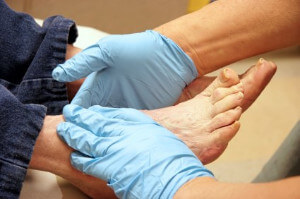 For individuals living with diabetes, foot care is of paramount importance. Diabetes can lead to a range of complications, including nerve damage and poor blood circulation, which can make even minor foot wounds a cause for concern. In this blog post, we'll delve into the unique challenges posed by diabetic foot wounds and how a skilled podiatrist plays a pivotal role in their treatment and healing process.
For individuals living with diabetes, foot care is of paramount importance. Diabetes can lead to a range of complications, including nerve damage and poor blood circulation, which can make even minor foot wounds a cause for concern. In this blog post, we'll delve into the unique challenges posed by diabetic foot wounds and how a skilled podiatrist plays a pivotal role in their treatment and healing process.
Understanding Diabetic Foot Wounds
Diabetic foot wounds are a complex issue that requires specialized attention. Due to reduced sensation and compromised blood flow, individuals with diabetes are at higher risk of developing wounds on their feet that can progress rapidly if not properly managed. These wounds can range from ulcers, which are open sores, to more superficial cuts and blisters.
The Role of a Podiatrist in Diabetic Foot Wound Care
Early Detection and Diagnosis: A podiatrist is trained to recognize the subtle signs of potential foot problems in diabetic patients. Through regular screenings and comprehensive examinations, they can identify wounds at their earliest stages, often before they become serious issues.
Expert Wound Management: Podiatrists have extensive experience in wound care, particularly in cases involving diabetes. They employ advanced techniques for wound cleaning, debridement (removal of dead tissue), and specialized dressings to promote optimal healing.
Pressure Redistribution and Offloading: Diabetic foot wounds are often exacerbated by pressure points. A podiatrist can provide custom orthotics or recommend specific footwear that redistributes pressure, reducing the risk of further damage.
Infection Prevention and Management: Diabetes can weaken the body's ability to fight infections. Podiatrists are skilled in identifying and treating infections promptly, using targeted therapies to ensure wounds heal without complications.
Coordination of Care: A podiatrist often collaborates closely with other healthcare providers involved in a diabetic patient's care, such as endocrinologists and primary care physicians. This ensures a comprehensive approach to managing diabetes and its related complications.
Education and Empowerment: Podiatrists play a crucial role in educating diabetic patients about foot care best practices. This empowers individuals to take an active role in their own well-being, reducing the risk of future complications.
Long-term Monitoring and Prevention: Even after a diabetic foot wound has healed, ongoing care and regular check-ups with a podiatrist are essential. They can provide guidance on maintaining healthy foot habits and identifying potential issues early.
For individuals with diabetes, proper foot care is not only a matter of comfort but also a critical component of overall health. Diabetic foot wounds require specialized attention and expertise, which a podiatrist is uniquely qualified to provide. By partnering with a skilled podiatrist, individuals can navigate the challenges posed by diabetes with confidence, knowing they have a dedicated ally in their journey towards healing and maintaining optimal foot health. Remember, your feet are your foundation – take care of them, and they'll take care of you.
If you have any questions, please feel free to contact our office located in Oradell, NJ. We offer the newest diagnostic and treatment technologies for all your foot care needs.
Tips to Prevent Jogging and Running Injuries

Running and jogging are fantastic ways to stay active and maintain physical fitness, but they also come with potential injury risks. To ensure you can enjoy these activities safely and remain injury- free, consider these key strategies. Firstly, invest in the right footwear. Proper running shoes provide essential support, cushioning, and shock absorption to minimize the risk of injuries. It is important to make sure they fit well and match your gait. Always prioritize warm up and cool down routines. Dynamic stretches before your run and static stretches afterward can improve flexibility and reduce the risk of muscle strains. Progressive training is vital. Gradually increasing the intensity and duration of your runs can allow your body to adapt and reduce the risk of overuse injuries. Lastly, mix up your running surfaces to reduce the impact on your joints. Incorporating grass, trails, and tracks into your routine can help prevent overuse injuries on harder surfaces. By following these guidelines, you can minimize the risk of running and jogging injuries, making these activities enjoyable and sustainable parts of your fitness regimen. For more information on effective running injury prevention techniques, it is suggested that you contact a podiatrist who can provide you with this knowledge.
All runners should take extra precaution when trying to avoid injury. If you have any concerns about your feet, contact one of our podiatrists of New Jersey Foot & Ankle Centers. Our doctors will treat your foot and ankle needs.
How to Prevent Running Injuries
There are a lot of mistakes a runner can make prior to a workout that can induce injury. A lot of athletes tend to overstretch before running, instead of saving those workouts for a post-run routine. Deep lunges and hand-to-toe hamstring pulls should be performed after a workout instead of during a warmup. Another common mistake is jumping into an intense routine before your body is physically prepared for it. You should try to ease your way into long-distance running instead of forcing yourself to rush into it.
More Tips for Preventing Injury
- Incorporate Strength Training into Workouts - This will help improve the body’s overall athleticism
- Improve and Maintain Your Flexibility – Stretching everyday will help improve overall performance
- “Warm Up” Before Running and “Cool Down” Afterward – A warm up of 5-10 minutes helps get rid of lactic acid in the muscles and prevents delayed muscle soreness
- Cross-Training is Crucial
- Wear Proper Running Shoes
- Have a Formal Gait Analysis – Poor biomechanics can easily cause injury
If you have any questions, please feel free to contact our office located in Oradell, NJ . We offer the newest diagnostic and treatment technologies for all your foot care needs.
Healing Foot Wounds: The Vital Role of a Podiatrist
 Our feet are one of the most hardworking and often neglected parts of our body. It's not uncommon for people to experience foot wounds, which can range from minor cuts and scrapes to more serious injuries. Seeking prompt and professional care for foot wounds is crucial to ensure proper healing and prevent complications. In this blog post, we'll explore the importance of addressing foot wounds and how a podiatrist plays a pivotal role in the healing process.
Our feet are one of the most hardworking and often neglected parts of our body. It's not uncommon for people to experience foot wounds, which can range from minor cuts and scrapes to more serious injuries. Seeking prompt and professional care for foot wounds is crucial to ensure proper healing and prevent complications. In this blog post, we'll explore the importance of addressing foot wounds and how a podiatrist plays a pivotal role in the healing process.
The Significance of Foot Wounds
Foot wounds can occur due to a variety of reasons, such as accidents, friction, or underlying medical conditions like diabetes. Regardless of the cause, it's essential to treat them with care and attention. Neglecting foot wounds can lead to infections, delayed healing, and in severe cases, even long-term damage.
Here are some common types of foot wounds:
Cuts and Abrasions: Superficial wounds that can range from minor scrapes to deeper cuts.
Blisters: Fluid-filled pockets that form due to friction or pressure.
Ulcers: Open sores that may result from poor circulation, nerve damage, or pressure points.
Ingrown Toenails: When the edge of a toenail grows into the surrounding skin, causing pain and potential infection.
The Role of a Podiatrist
A podiatrist is a specialized healthcare professional who focuses on diagnosing, treating, and preventing conditions related to the feet, ankles, and lower legs. When it comes to foot wounds, a podiatrist is an invaluable resource for several reasons:
Expert Diagnosis: Podiatrists are highly trained in identifying and evaluating various types of foot wounds. They have the expertise to differentiate between superficial injuries and those that require more extensive treatment.
Customized Treatment Plans: Based on the specific nature of the foot wound, a podiatrist will develop a tailored treatment plan. This plan may include wound cleaning, debridement (removing dead tissue), and appropriate dressing.
Preventing Infections: Foot wounds are susceptible to infections, especially if not treated properly. Podiatrists are skilled in managing and preventing infections, ensuring wounds heal without complications.
Managing Underlying Conditions: For individuals with conditions like diabetes, which can impair wound healing, a podiatrist plays a crucial role in providing specialized care to prevent complications and promote optimal healing.
Expertise in Foot Biomechanics: In cases where wounds are related to abnormal foot mechanics or pressure points, a podiatrist can recommend orthotic devices or footwear modifications to alleviate stress on affected areas.
Post-Healing Care and Rehabilitation: After a foot wound has healed, a podiatrist can provide guidance on exercises, stretches, and ongoing care to prevent future injuries and promote overall foot health.
Foot wounds should never be taken lightly. Seeking timely and professional care from a podiatrist is paramount in ensuring proper healing and preventing complications. Remember, our feet carry us through life, and taking good care of them is essential for our overall well-being. If you or a loved one are dealing with a foot wound, don't hesitate to reach out to a trusted podiatrist who can provide the expert care needed for a swift and thorough recovery. Your feet will thank you!
Facts About Children Walking on Tiptoe
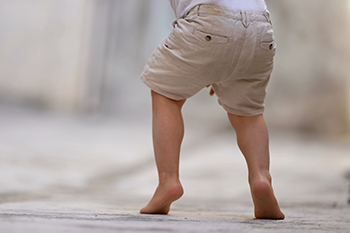
While occasional tiptoe walking is normal in toddlers who are exploring their bodies, persistent tiptoe walking may signal underlying issues that require attention from a podiatrist. One common cause is idiopathic toe walking, as sometimes children walk on tiptoe without any apparent reason. This condition usually resolves by the time the child is three years old, but persistent cases may require evaluation. Another potential cause is a tight Achilles tendon, as a shortened Achilles tendon can make it uncomfortable for a child to place their heels on the ground. Some children with sensory processing disorders may prefer tiptoe walking due to heightened sensitivity in their feet. Tiptoe walking can lead to muscle imbalances and joint issues in the long run, which may affect a child's balance and coordination, potentially leading to falls and injuries. If you notice that your child is frequently walking on tiptoe, it is suggested that you make an appointment with a podiatrist for a thorough evaluation and appropriate treatment. Early intervention can help your child develop a healthier, more comfortable gait.
The health of a child’s feet is vital to their overall well-being. If you have any questions regarding foot health, contact one of our podiatrists of New Jersey Foot & Ankle Centers. Our doctors can provide the care you need to keep you pain-free and on your feet.
Tips for Keeping Children's Feet Healthy
- Make sure their shoes fit properly
- Look for any signs of in-toeing or out-toeing
- Check to see if they have Clubfoot (condition that affects your child’s foot and ankle, twisting the heel and toes inward) which is one of the most common nonmajor birth defects.
- Lightly cover your baby’s feet (Tight covers may keep your baby from moving their feet freely, and could prevent normal development)
- Allow your toddler to go shoeless (Shoes can be restricting for a young child’s foot)
- Cut toenails straight across to avoid ingrown toenails
- Keep your child’s foot clean and dry
- Cover cuts and scrapes. Wash any scratches with soap and water and cover them with a bandage until they’ve healed.
If you have any questions, please feel free to contact our office located in Oradell, NJ . We offer the newest diagnostic and treatment technologies for all your foot care needs.
Causes and Relief Strategies for Swollen Feet
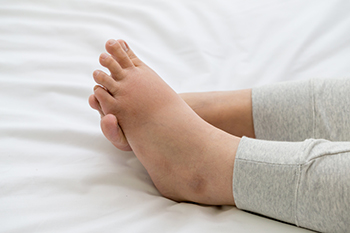
Swollen feet, a common issue that affects people of all ages, can be uncomfortable and concerning. To find relief, it is essential first to understand the underlying causes. One of the leading causes of swollen feet is fluid retention, often attributed to a sedentary lifestyle, excessive salt intake, or hormonal changes. Prolonged sitting or standing can also impede proper blood circulation, leading to swelling. Certain medical conditions, such as heart, kidney, or liver problems, can contribute to fluid buildup in the lower extremities. Another common factor is inflammation, which can result from injuries, infections, or chronic conditions such as arthritis. In some cases, medications or pregnancy may lead to incurring swollen feet. To relieve swollen feet, elevate your legs whenever possible, ideally above heart level, to encourage fluid drainage. Regular exercise, such as walking or ankle rotations, can help improve circulation. Reducing salt intake, wearing compression stockings, and staying hydrated are valuable preventive measures. If swelling persists or worsens, it is suggested that you consult a podiatrist to rule out any underlying medical conditions and explore additional treatment options.
Swollen feet can be a sign of an underlying condition. If you have any concerns, contact one of our podiatrists of New Jersey Foot & Ankle Centers. Our doctors can provide the care you need to keep you pain-free and on your feet.
Swollen feet are a common ailment among pregnant women and people who stand or sit for extended periods. Aging may increase the possibility of swollen feet and patients who are obese often notice when their feet are swelling too. There may be medical reasons why swollen feet occur:
- Phlebitis - A condition that causes the veins to become inflamed and can also cause leg pain.
- Liver disease - This may lead to low blood levels of albumin which is a protein. This can cause fluid in the blood to pass into the tissues and several areas of the body can become swollen.
- Heart failure - When the heart doesn’t pump properly the blood that is normally pumped back to the heart can pool in the veins of the legs causing swollen feet.
- Kidney disease - One of the main functions of the kidneys is releasing excess fluid in the body. This type of condition can make it difficult for the kidneys to function properly, and as a result the feet may become swollen.
- Deep-vein thrombosis (DVT)- This is a serious condition where blood clots form in the veins of the legs. They can block the return of blood from the legs to the heart which may cause the feet to swell. It is important to be treated by a podiatrist if this condition is present.
Swollen feet can also be caused by bone and tendon conditions, including fractures, arthritis, and tendinitis. Additionally, there may be skin and toenail conditions and an infection may cause the feet to swell. Patients who take medicine to treat high blood pressure may be prone to getting swollen feet.
Many patients elevate their feet to help relieve the swelling and this is generally a temporary remedy. When a podiatrist is consulted the reason behind the swelling can be uncovered and subsequently treated.
If you have any questions please feel free to contact our office located in Oradell, NJ . We offer the newest diagnostic tools and technology to treat your foot and ankle needs.
Causes of Running Injuries
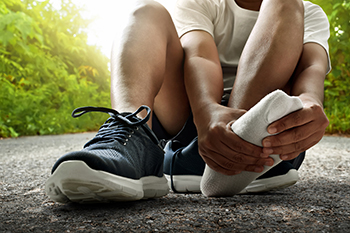
Running is thought to be a good way to stay fit and healthy, but it also comes with risks. Foot and ankle injuries are all too common among runners. Overuse is a prevalent issue, usually stemming from pushing your body too hard or increasing your mileage too quickly. These actions can lead to problems like plantar fasciitis, Achilles tendonitis, and stress fractures. Poor footwear choices also play a significant role in causing foot or ankle injuries. Worn-out or ill-fitting shoes fail to provide the necessary support and cushioning, increasing the risk of injuries. Ensuring your shoes are the right fit for your feet and running style is important. Inadequate warm-up routines can strain the muscles and ligaments, making them more susceptible to injuries. In addition, running on uneven terrain can increase the likelihood of twisting an ankle. Biomechanical issues, such as overpronation or supination, can place extra stress on your feet and ankles, making them prone to injury. If you experience persistent pain or discomfort as a result of your running activity, it is suggested that you consult a podiatrist for an exam, diagnosis, and treatment options.
Exercising your feet regularly with the proper foot wear is a great way to prevent injuries. If you have any concerns about your feet, contact one of our podiatrists of New Jersey Foot & Ankle Centers. Our doctors will treat your foot and ankle needs.
How to Prevent Running Injuries
Many common running injuries are caused by overuse and overtraining. When the back of the kneecap starts wearing out and starts causing pain in your knee, this is commonly referred to as runner’s knee. Runner’s knee is a decrease in strength in your quadriceps and can occur if you’re not wearing properly fitted or supporting shoes. To prevent runner’s knee, focusing on hip strengthening is a good idea, as well as strengthening your quads to keep the kneecaps aligned.
What Are Some Causes of Running Injuries?
- One cause of a common running injury is called iliotibial band syndrome.
- Plantar fasciitis is also another common injury.
- Stress fractures can occur from overtraining, lack of calcium, or even your running style.
Best Ways to Prevent Running Injuries
- Wear footwear that fits properly and suits your running needs.
- Running shoes are the only protective gear that runners have to safeguard them from injury.
- Make a training schedule. Adding strengthening exercises as well as regular stretching can help keep you strong and limber and can lessen the possibility of injuries.
- Stretching keeps muscles limber; this will help you gain better flexibility.
If you have any questions please feel free to contact our office located in Oradell, NJ . We offer the newest diagnostic and treatment technologies for all your foot and ankle needs.
Featured Articles
- July 2025
- June 2025
- May 2025
- April 2025
- March 2025
- February 2025
- January 2025
- December 2024
- November 2024
- October 2024
- September 2024
- August 2024
- July 2024
- June 2024
- May 2024
- April 2024
- March 2024
- February 2024
- January 2024
- December 2023
- November 2023
- October 2023
- September 2023
- August 2023
- July 2023
- June 2023
- May 2023
- April 2023
- March 2023
- February 2023
- January 2023
- December 2022
- November 2022
- October 2022
- September 2022
- August 2022
- July 2022
- June 2022
- May 2022
- April 2022
- March 2022
- February 2022
- January 2022
- December 2021
- November 2021
- October 2021
- September 2021
- August 2021
- July 2021
- June 2021
- May 2021
- April 2021
- March 2021
- February 2021
- December 2020
- November 2020
- August 2020
- June 2020
- April 2020
- March 2020
- February 2020
- January 2020
- December 2019
- November 2019
- October 2019
- September 2019
- August 2019
- July 2019
- June 2019
- May 2019
- April 2019
- March 2019
- February 2019
- January 2019
- December 2018
- November 2018
- October 2018
- September 2018
- August 2018
- June 2018
- May 2018
- April 2018
- March 2018
- February 2018
- January 2018
- December 2017
- November 2017
- October 2017
- September 2017
- August 2017
- July 2017
- June 2017
- May 2017
- April 2017
- March 2017
- February 2017
- January 2017


